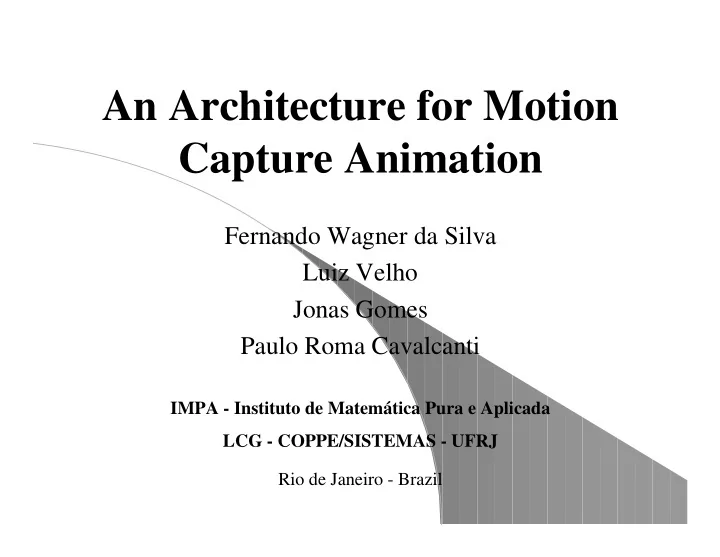

An Architecture for Motion Capture Animation Fernando Wagner da Silva Luiz Velho Jonas Gomes Paulo Roma Cavalcanti IMPA - Instituto de Matemática Pura e Aplicada LCG - COPPE/SISTEMAS - UFRJ Rio de Janeiro - Brazil
General Outline ● Computer Animation Systems ● Motion Capture (MoCap) ● MoCap Animation System ● System’s Architecture ● Conclusions ● Future work / Work in progress
Motion Capture (MoCap) ● Motion recording by sampling at points of a real subject ● Advantages – natural looking motion. – speed of production. ● Drawback – data complexity and size.
MoCap Hardware Technology ● Optical � high sampling rates. � no angular data. � requires post-processing. ● Magnetic � real-time animation. � high encumbrance (lots of cables). � low sampling rate. ● Hybrid
Computer Animation Systems ● Keyframing – interpolation between key poses. ● Procedural – procedure parameters over time. ● Simulation – physical constraints and rules.
Our Motivation ● MoCap is different from traditional animation data ● Existing systems are not suitable for MoCap processing There is a need for specialized MoCap processing systems
Our MoCap Animation System ● MoCap as main animation tool ● Modular architecture ( Input , Processing , Output and Interface ) ● Specialized GUI objects sharing a dynamic state structure
System’s Architecture Interface Input Processing Output Data Structures
System’s Architecture Interface Data Structures • Entities • Operations • Actor • Control • Motions
System’s Data Structures ● Basic entities – virtual actor: topology + geometry. – motions: sampled data.
System’s User Interface ● Graphic objects (widgets) – designed to work with MoCap data. – based on video post-production paradigm.
System’s Architecture Input Processing Output • Motion operations • Interpretation • Reusable motion • Pre-processing libraries • MoCap format • Relative angle extraction converter
System’s Architecture - Input ● Interpretation – support to different file formats. ● Pre-processing – detection of holes in MoCap data. ● Relative angle extraction – conversion of positional data to relative angles.
Relative Angle Extraction ● Needed for motion processing – can be mapped onto a position-independent skeleton hierarchy. – easy integration with other animation techniques (forward & inverse kinematics). ● 3 DOF Euler angles extracted via geometric algorithms
System’s Architecture - Processing ● Motion operations – motion analysis, modification and reuse. – preserve the original quality of the motion. ● Extensibility – inclusion of new operations as plug-ins.
Motion Operations ● Unary (filtering, warping) – one motion as operand. – modification of motion’s characteristics. ● Binary (concatenation) – two motions as operands. – creation of longer animations. ● N-ary (blending) – two or more motions as operands. – mix different motion styles/characteristics.
System’s Architecture - Output ● Data portability – conversion between file formats. ● Skeleton hierarchy data – relative angles information. ● Rendering pipeline – frame by frame rendering in professional systems.
Implementation Issues ● C Language + UNIX ● Rendering: OpenGL ● Standard GUI facilities: XForms ● Real-time frame rates ● Tested on SGI, RS6000 and Linux
Conclusions ● MoCap based systems – correct representation of MoCap abstractions. – integration with capturing systems. – what is the minimum set of operations? ● Proposed Architecture – deals with some limitations of the process. – easy integration of new techniques.
Future Work / Work in Progress ● Other motion operations – motion cyclification. – multiresolution filtering. ● New techniques – motion time-warping. – motion/sound synchronization. ● Other animation tools/techniques – Inverse kinematics. – Procedural.
Additional Info http://www.visgraf.impa.br/mocap
Recommend
More recommend